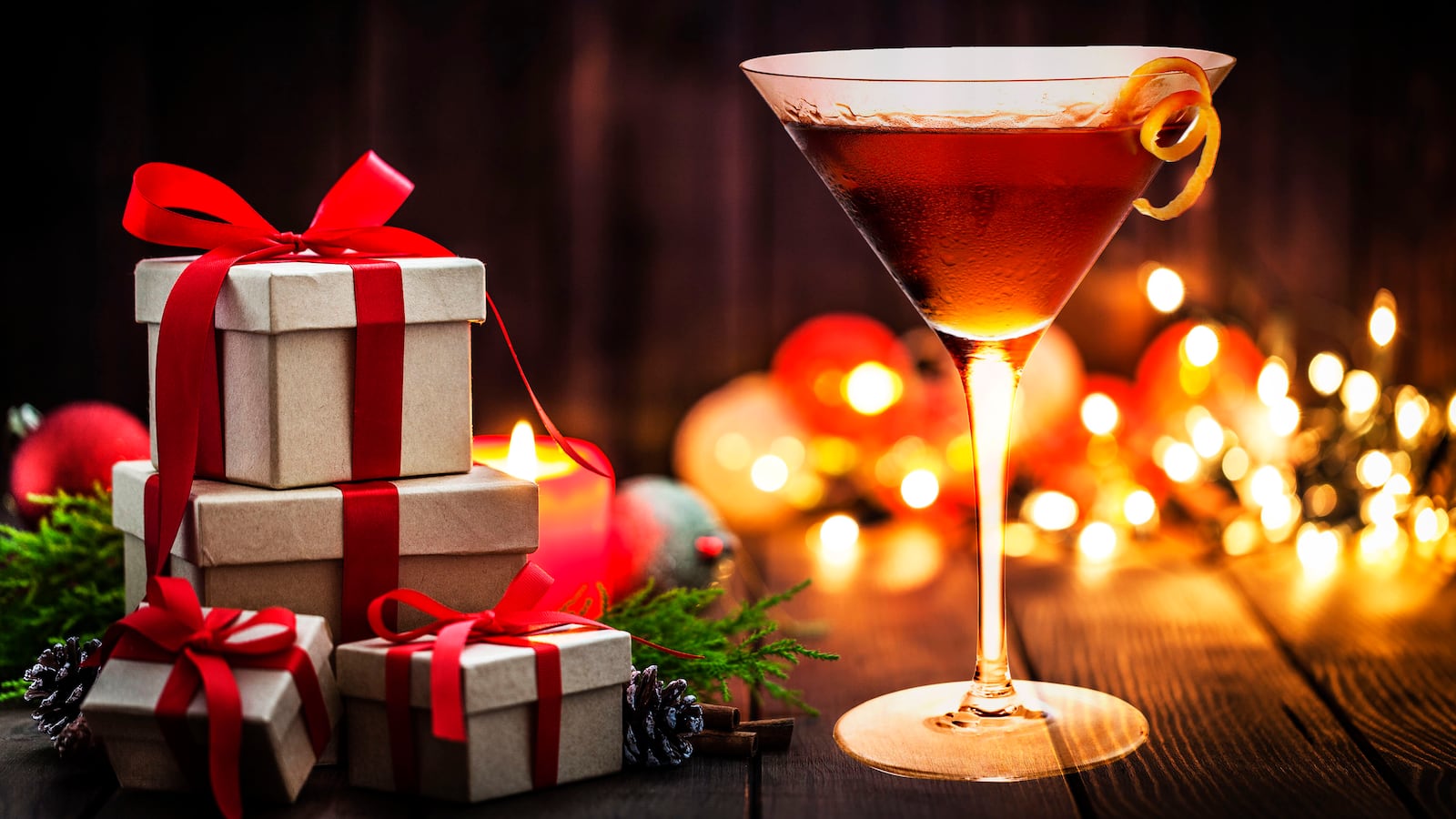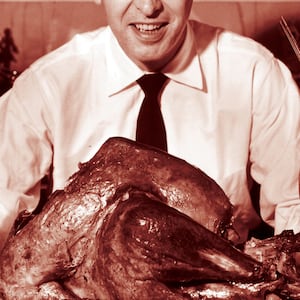Normally, this time of year I’d be offering suggestions for something with which to charge the flowing bowl, so that its bounty, ladled out with cheer and kindly hospitality, would make the intolerable among your family and acquaintances tolerable and the tolerable truly delightful.
There would be soft-focus anecdotes about Charles Dickens or some old English earl, Dutch “Mynheer” or not-so-very-proper Bostonian. There would be rum and port and a thick dusting of freshly grated nutmeg. It would be jolly—damned jolly.
But this holiday season, with the specter of COVID-19 hanging over us all, the idea of gathering in close and cozy quarters with a gang of people who aren’t in my immediate household sends a rivulet of cold sweat down my back. And if I’m not going to do it, I’m certainly not going to cheerfully suggest others do.
At the same time, our seasonal social rituals are important. I can easily understand why some people are saying “to hell with the coronavirus pandemic, we’re doing Christmas anyway,” even if I think it’s naïve and dangerous to them and everyone they’re going to come in contact with. Life is difficult enough in normal times. In hard times like these, it can be bleak indeed. What we as humans have to brace ourselves against that bleakness is each other.
As the old saw goes, soldiers don’t fight for their countries, they fight for their fellow squad members. We need our squad members to get us through, whether that means Mom and Dad, aunts, cousins and such, or just—“just”—the usual crew of friends old and new that we’ve recruited over the years. We need to see them, touch them, talk to them. Relax with them. Put the load we’re carrying aside for a bit and share some laughs and reminiscences.
In my household, anyway, we usually do that over a drink. Mixing someone a little glass of something delightful is a quick and very effective first manifestation of hospitality; a way of not just telling them, but showing them that they’re truly welcome and, at least for now, among their people.
Fortunately, if we can’t physically be with our people, at least we can still mix them that drink; still show them at least that little bit of hospitality. Sure, we’ll have to do our toasting via Zoom, FaceTime, group texts, WhatsApp, etc. If the idea of that fills you with the same measure of joy it fills me with, which is less than a metric teaspoonful, at least know that with the help of a few empty bottles, some booze and a little planning in advance you can still extend that hospitality; still pour them that drink. It takes a little planning, but hey, you’ve got time these days. All you have to do is, at some point before you log on, drop off or send them a little bottled cocktail, one where everything is done and all your people have to do is pour.
Bottled cocktails have a long and successful history that we absolutely don’t need to get into here. Suffice it to say that, just as modern bars have learned to make their drinks portable during the current pandemic, bars in the nineteenth century did the same as a matter of course for their customers who might want a cocktail at home—this was before the whole be-your-own-bartender idea took hold—or wherever else no bar was to be found. (Such places existed, although there weren’t many.) While these bottled cocktails couldn’t replicate the experience of standing at the carved mahogany bar while the bartender waltzes the ice around in his glass and then pours an amber stream from a great height into a tiny little cocktail glass with perfect accuracy, the cocktail itself didn’t know that: it was the same delicious potion, minus the show. And that’s what your people will be getting.
For bottled cocktails, you need bottles. I like to use 1-pint Mason jars, which hold enough for four standard drinks, fully diluted and with no need for stirring, shaking or any of that business. (When you mix drinks with ice, it’s the ice-melt that chills them and dilutes them enough to kill the burn. For these, you’re going to add the same amount of water and let your friends’ freezers do the chilling.)
If you can’t get pint Mason jars, use what you can get—old wine bottles, cleaned and with the labels soaked off and glass 12-oz soda bottles are also good, although you’ll have to adjust your proportions. For those last, you’ll also need corks.
You’ll also need labels. They don’t have to be fancy: you can hand-write them and tape them on with clear packing tape. But your people will need a little information on what they’re drinking, how many the bottle serves, and how to store the drink, prepare it and serve it. We’ll get into the details below.
There are two kinds of bottled cocktail: the kind that’s shelf-stable, and the kind that comes with the fuse lit; that has to stay refrigerated and even then will only keep for a couple of days. The options for each are endless, but since the sponsor for this particular post is Jefferson’s Bourbon, I’m going to stick to whiskey drinks, which is certainly no hardship.
Let’s start with a shelf-stable one, the Manhattan Club’s version of the Manhattan. Seeing as the Manhattan was most likely invented at the Manhattan Club (a New York political and social club), sometime around 1880, this version carries a certain authority. With equal parts whiskey—we’ll go with the Jefferson’s Reserve, which is 45 percent alcohol, a good mixing strength—and vermouth, it’s also softer and a little less rambunctious than the standard version, and hence maybe a bit better adapted for the all (legal) ages crew you get at holiday time.
This drink will keep indefinitely, which means that it can be sent or dropped off considerably in advance of consumption. You might want to add a lemon with each pint, for peels (they should be cut in vertical strips with a vegetable peeler, an excellent thing to demonstrate over Zoom).
Here’s how you make one:
INGREDIENTS
- 1.5 oz Jefferson’s Reserve Bourbon
- 1.5 oz Italian red vermouth
- 3 dashes Orange bitters
- Glass: Cocktail
- Garnish: Lemon peel
DIRECTIONS
Add all of the ingredients to a mixing glass and fill with cracked ice. Stir, and strain into a chilled cocktail glass. Twist a swatch of thin-cut lemon peel over the top.
And here’s how you make a pint of them, which should be enough for four regular-sized cocktails.
INGREDIENTS
- 6 oz Jefferson’s Reserve Bourbon
- 6 oz Italian red vermouth
- 12 dashes Orange bitters
- 4 oz Bottled water
DIRECTIONS
Add all of the ingredients to a 1-pint Mason jar. Seal the jar and label it.
Here’s how I’d label this:
The Manhattan Club’s Manhattan
As served at the place that invented it, New York, 1882.
Bourbon, Italian vermouth and orange bitters.
Contains four drinks.
To serve: Put this bottle in the freezer for 45 minutes and then pour into four chilled cocktail glasses. If possible, twist a strip of lemon peel over the top.
This bottle can be stored at room temperature.
With big hugs from [your name here].
(If your people are a little more adventurous and boozy—we don’t judge here at the Daily Beast—and you have access to an exceptionally well-stocked liquor store, a great, unusual variation is the Racquet Club Special, as served by Harry, head bartender of the Detroit Racquet Club, in 1934: for one, it’s 2 oz Jefferson’s Reserve Bourbon to .5 oz each Italian vermouth and Kronan Swedish Punsch, a cane spirit-based liqueur that brings a little complexity to the proceedings, and a couple of dashes of Peychaud’s Bitters. For four, that’s 8 oz Jeffferson’s to 2 oz each vermouth and Swedish Punsch, 8 dashes Peychaud’s and 4 oz water. Assemble the same way.)
Now, some people will find an all-booze drink like the Manhattan to be a bit much, even if you’ve mixed it up in one of its mellowest incarnations. For them, there’s the Ward Eight, a lovely turn-of-the-20th-century twist on the Whiskey Sour out of Boston, named after the political ward that coincided with the city’s North End. There are as many recipes for this drink as there were old-time bartenders in Boston. My favorite, though, is the one (contributed by one of those old-timers) that slips a little amontillado sherry into the mix, which makes it taste richer and far more intriguing.
Unfortunately, sours like this have a short shelf-life before the citrus juice starts to mutate in strange and un-tasty ways. Ideally, this should be made the morning of the day it’s going to be consumed. The day before is acceptable. Beyond that there’s a good chance the lemon juice will go off (it won’t hurt anyone, but it will taste nasty). In either case, it has to be kept refrigerated, so plan accordingly.
INGREDIENTS
- 2 oz Jefferson’s Very Small Batch Bourbon
- .5 oz Amontillado sherry
- .5 oz Fresh lemon juice
- .25 oz Fresh orange juice
- Scant .5 oz Grenadine (the regular commercial stuff is fine here)
- Club soda
- Glass: 8-oz Goblet
DIRECTIONS
Add all of the ingredients, except the club soda, to a shaker and fill with ice. Shake, and strain into a stemmed goblet. Add 1 ice cube and a splash of sparkling water.
And for four:
INGREDIENTS
- 7 oz Jefferson’s Very Small Batch Bourbon
- 1.75 oz Amontillado sherry
- 1.75 oz Fresh lemon juice
- 1 oz Fresh orange juice
- 1.5 oz Grenadine
- 3 oz Bottled water
DIRECTIONS
Add all of the ingredients to a 1-pint Mason jar. Seal the jar, label it and refrigerate it.
When delivering this, add a small bottle of club soda per pint bottle of Ward Eight. That, too, should be refrigerated, of course.
And the label (adjust to suit, naturally):
The Ward Eight
The Boston classic, created to celebrate a local election win in that city’s eighth ward, ca. 1900.
Bourbon, sherry, lemon and orange juices and a touch of grenadine.
Contains four drinks.
To serve: Put this bottle in a freezer for 45 minutes and then pour into four white wine glasses, each with an ice cube in it. Add a splash of chilled soda water to each.
This bottle must be kept refrigerated and used within 24 hours.
With big hugs from [your name here].







